Project members
- Natalia Aralova (MPI-EVA)
- Alexandra Lavrillier (Université Versailles Saint-Quentin-en-Yvelines)
- Dejan Matić (MPI fuer Psycholinguistik, Nijmegen)
- Brigitte Pakendorf (CNRS & Université Lumière Lyon 2, Dynamique du Langage)
- Evgeniya Zhivotova (MPI-EVA)
- Luise Zippel (MPI-EVA)
Dialectal and cultural diversity among Ėvens in Siberia
The project was funded by Volkswagen Foundation and DoBeS Programme.
Project
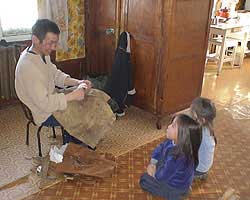
Ėven is a Northern Tungusic language spoken over a vast area of northeastern Siberia, from the Lena-Jana watershed in the west to the coast of the Oxotsk Sea, Chukotka, and Kamchatka in the east. Traditionally, Ėvens are nomadic hunters and reindeer pastoralists. Reindeer, both domesticated and wild, play an important role in their culture and ethnic self-identification. Reindeer herding, however, has become highly endangered throughout the Russian North, which has had extremely negative effects on the Ėvens' self-perception and social relations. Therefore the project did not only seek to document the language, but also the state of reindeer herding among the Ėvens in different regional settings.
Due to the fragmentation of the Ėven communities, several dialects have emerged which are classified into two major dialectal groups: Western and Eastern. These dialects form a continuum with pronounced lack of mutual intelligibility between the extremes. So far, only two variants of one of the dozen or more dialects have been documented to a notable extent; these variants are also the least endangered ones. Other dialects are either on the verge of extinction or moribund.
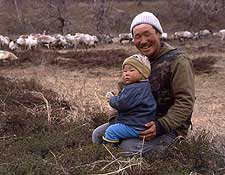
The project aimed at documenting three highly endangered variants of Ėven that currently still have enough fluent speakers to make a comprehensive documentation feasible. These are the dialect spoken in the village of Sebjan-Küöl in the Republic of Sakha (Yakutia), which is the westernmost Ėven dialect still spoken; the dialect spoken in the village of Topolinoe in Yakutia, which also belongs to the Western dialect group, but is in an intermediate geographic location and the dialect spoken in the Bystraja district on Kamchatka representing the Eastern dialect group. We attempted to record speech from as many fluent individuals as were willing to contribute their knowledge to the project, and to cover as wide a range of genres as possible, including folklore, procedural texts, oral life histories, and spontaneous conversations.
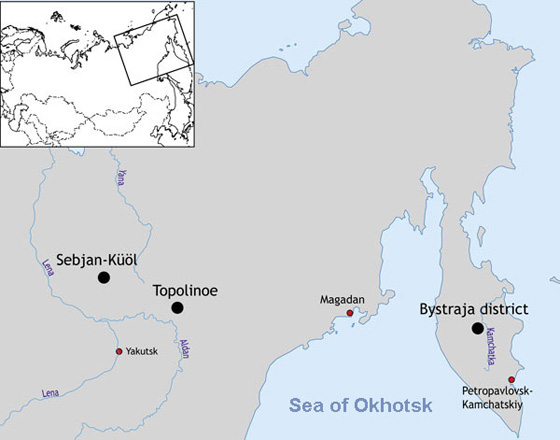
Given the importance of reindeer herding for Ėven culture and self-identification, a thematic focus was the collection of ethnographic and linguistic data pertaining to the domain of reindeer husbandry. To this aim, reindeer terminology was collected and illustrated photographically, and procedural texts describing various aspects of reindeer husbandry (such as the preparation of leather and the sewing of herders’ garments, the construction of the traditional nomadic yurt, the saddling and harnessing of reindeer) were elicited. This linguistic focus on reindeer was mirrored by the ethnographic documentation of the role of reindeer husbandry in the modern Ėven ways of life. A strong focus of the project was on the collection of comparable data, in order to enable the documentation of cultural and linguistic differences as well as similarities. For this purpose, the elicitation of texts and information dealing with identical topics in all three field sites was emphasized.
Sebjan-Küöl

Sebjan-Küöl (Sebjan for short) is located approximately 400-500 km to the north of Yakutsk in the Verkhoyansk mountain range, on a tributary of the Dulgalakh river, which in turn flows into the Yana river further north. For most of the year, it is reachable only by air (helicopter or small biplanes); only in late winter and early spring (from the end of December until mid- to late April) can the village be reached by truck along frozen rivers (the so-called ‘winter highway’).
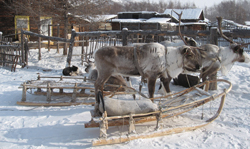
Sebjan-Küöl was first founded in 1932, when it was part of the ‘national district’ of Sakkyryyr, together with other predominantly Ėven-speaking settlements further north. In 1965 the Sakkyryyr district was disbanded, and Sebjan-Küöl was included in the Kobjaj district of which it is still a part.
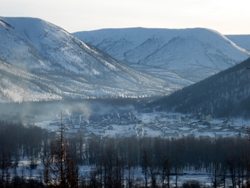
Sebjan is a predominantly Ėven village with not quite 800 inhabitants, of which approximately 85% are registered as Ėvens, with the remainder being predominantly Sakha (Yakuts). Its isolated location might account for the fact that the Ėven language in Sebjan is currently still being transmitted to (some) children, although Sakha (Yakut) has taken over as the dominant language in public use. The village subsists mainly on reindeer breeding, with 11 reindeer brigades herding over 15,000 reindeer, several thousands of which are privately owned. Life amongst the reindeer herders of Sebjan-Küöl in the 1990s is vividly described in the book ‘Reindeer People’ by Piers Vitebsky.
Vitebsky, Piers (2005): Reindeer People. Living with Animals and Spirits in Siberia. London et al: Harper Perennial.
Topolinoe
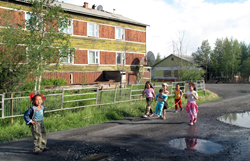
The village of Topolinoe is located in the Tompo District of the Republic of Sakha, some 500 km to the north-east from Yakutsk. The village is situated on the south-eastern fringe of the Verkhoyansk mountain range, on the left bank of the river Tompo, around 600m above sea level. It was founded in the early 1970s to replace the old village of Tompo, which had been the main settlement of Tompo Ėvens since the late 1940s.
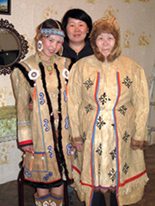
There are approximately 900 people living in the village, some 800 of which are ethnic Ėvens, the others being mostly Sakha (Yakuts) and Russians. Apart from hunting, which is still an important form of subsistence, the main occupation of Tompo Ėvens is reindeer herding. Despite the adversities of the post-Soviet era, the number of reindeer belonging to the people of Topolinoe has remained comparatively large: in summer 2009, there were roughly 20,000 animals organised in 16 herds. The herds and the herders roam the taiga throughout the year along the mountain rivers of the Verkhoyansk and the Suntar-Khayata ranges. They are concentrated in three groups – the south-western group around the river Baray, the northern group around the Adyča River, and the eastern group close to the river Suntar.
These three pasturing grounds correspond to the locations of the historical groups of Ėvens which the Soviet administration first united in the Tompo District in the early 1930s and then settled together in the village of Tompo during the sedentarisation campaign in the late 1940s. These are the Baray Ėvens, who used to roam the taiga in the west, the Adyča and Memel Ėvens in the northern and in the central parts of the region, and the Suntar Ėvens in the east.
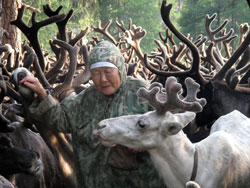
The joining of different clans has had interesting linguistic consequences. The older speakers of Tompo Ėven are still aware of the differences between the three groups: Baray Ėven shows affinities with the western dialect of Sebjan-Küöl and displays strong Sakha influence, Adyča Ėven represents a variety of the northern Indigirka dialects, while Suntar Ėven belongs to the group of dialects spreading from Oymyakon to the Sea of Okhotsk. In the speech of the middle generation, which is also the last generation to have learned Ėven as their mother tongue, the differences seem to have levelled off, giving rise to a new variety with a dominant Adyča component.
In spite of the preservation of the traditional subsistence pattern and the teaching of Ėven at school, inhabitants of Topolinoe under thirty have only a limited or no knowledge of their heritage language.
Bystraja district
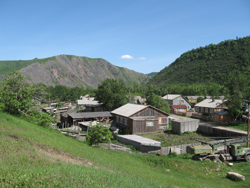
The Bystraja district, which was formed in 1926, is located in the centre of the Kamchatkan Peninsula. Currently it contains only two main settlements, the administrative centre Esso, and Anavgai. The villages can be reached from Petropavlovsk-Kamchatskij, the capital of the Kamchatka Region (Kamchatka Krai), by a daily bus route. Esso is 530 km away from Petropavlovsk, and Anavgai lies 25 km to the northwest of Esso. In 2006, the Bystraja district counted approximately 3,000 inhabitants, of which nearly 900 (~30%) were Ėvens (Gernet 2008). Slightly less than half of the Ėvens live in Anavgai, where they are the majority group. Nowadays, the overall majority in the district is made up of Russians; in addition, there is a sizeable Koryak community that lives mostly in Anavgai.
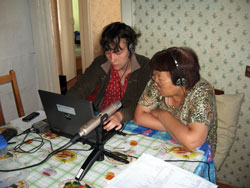
The Ėvens appeared in Kamchatka as late as the mid-19th century, when several Ėven clans immigrated from Eastern Siberia. They led a fully nomadic way of life until the 1920s without settling down. In 1926, the settlements Anavgai, Lauchan, and Kekuk were formed, and in 1932, Esso was declared the administrative centre of the National (Ėven) Bystraja district. From the 1950s, several predominantly Ėven settlements (amongst others, Kekuk, Lauchan, and Bystraja) were closed down in the course of the enlargement policy of the Soviet state, in which smaller collective farms were merged into larger units. The inhabitants of the disbanded settlements were relocated to Twajan (which was in its turn shut down in the mid-1970s), Anavgai and Esso. In the Kamchatka Region, Ėvens are also settled in the Oljutor and Penzhina districts (Burykin 2004).
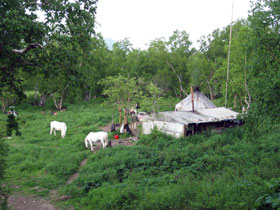
The indigenous inhabitants of the Bystraja district predominantly practise hunting and fishing, in addition to several reindeer herding brigades. A characteristic feature of indigenous life in this area are also the traditional so-called ‘fishing camps’. These are autonomous homesteads consisting of a yurt as well as several outbuildings and occasionally even a vegetable patch, which are located on rivers that are visited by the salmonid runs. As a rule, older people live here year-round, while younger family members visit for the summer months.
In the Bystraja district, the Ėven language is currently severely endangered, being replaced by Russian. According to the most optimistic estimates of the speakers themselves, Ėven is only in use amongst people older than 40, and it is not being transmitted to children anymore.
Gernet, Katharina (2008) "Kulturrevolution" in Zentral-Kamtschatka: Die Integration der evenischen Rentiernomaden in die sowjetische Gesellschaft. Harrassowitz Verlag, Wiesbaden.
Burykin, A.A. (2004) Язык малочисленного народа в его письменной форме. Петербургское Востоковедение, Санкт-Петербург [A minority language in its written form]